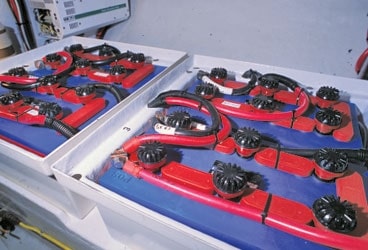
winterized batteries 368
It’s well understood by anyone who lives in a cooler climate and owns a car that the colder it gets, the harder it is to start the engine, particularly if the battery is weak. In fact, as temperatures drop, the efficiency of a lead-acid battery falls dramatically, no matter the type: flooded-cell, gel, or AGM. A battery that provides 100 percent of its capacity at room temperature will produce about 60 percent of that energy when the temperature falls to 20 F. So it’s no secret that batteries suffer when the temperature drops. But is that statement accurate in all circumstances? As it turns out, when it comes to battery storage, nothing could be farther from the truth.
I have a clear recollection from childhood of my father storing flashlight and transistor-radio batteries in the refrigerator. When I grew up, I naturally followed his lead and did the same, without really knowing why.
(Many parents will recognize this pattern.) It wasn’t until years later that I discovered that chemistry supported Dad’s actions. Contrary to popular belief, while batteries may not work very well when they’re very cold, they store exceptionally well in cold temperatures because their “metabolism” slows down.
There is, however, one important caveat to the rule of cold storage for batteries: They must be fully or nearly fully charged when left in this state. Discharged batteries, cold or warm, will suffer from sulphation, a process in which lead sulphate, which forms naturally during battery discharging, hardens into crystalline form. Once this occurs, the crystals resist reintegration during the charging process, which results in reduced battery efficiency.
More important from the point of view of cold-storage, however, is that even a partially discharged battery will freeze at temperatures as high as 20 F. If a battery is allowed to freeze, it may be damaged internally or, worse, the case may crack. A fully charged battery’s freezing point, on the other hand, is somewhere around minus 95 F. Additionally, flooded batteries experience a self-discharge of approximately 1 percent per day at room temperature, which means they should be recharged at least monthly. Because their metabolism increases as the thermometer rises, they discharge more rapidly at higher temperatures, so more frequent recharging is often necessary in the tropics. Because of this phenomenon, chances are good that if you store your battery aboard in cold climates and make sure that it’s fully charged when you put it to sleep, it will maintain this charge, provided no loads are present, for several months. Thus, cold storage is actually preferable. Periodic charging, monthly or as needed, will ensure that the battery remains topped up and that it resists freezing and sulphation. (Note: Never charge a battery that’s been or is suspected of having been frozen. It must first be thawed and inspected for damage.) If you’re using a temperature-compensated charger-and you should be-don’t be surprised to see charge voltages as high as 15 volts when the mercury is in the nether regions. This is normal for cold batteries, and it’s just what they need when they’re in this frosty state.
Finally, if you have a flooded-cell battery, top off the electrolyte using distilled water before storing, and do so only after charging (unless the plates are exposed; then add water before charging). And no matter what the technology of your battery, make sure that the top of the battery is clean and free of corrosion. Terminal contact surfaces (not the exterior of the terminal) should be coated with a conductant paste, such at T&B Kopr-Shield (www.tnb.com). The exterior of the reassembled terminal can then be coated with an anti-corrosion spray, such as CRC’s Heavy-Duty Corrosion Inhibitor (www.crcindustries.com). In this cool, charged, and corrosion-free state, your battery should live quite happily through the winter.
Steve D’Antonio, a regular CW contributor, runs Steve D’Antonio Marine Consulting. Next month, he writes about winterizing water tanks.








